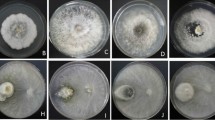Abstract
A total of 21 endophytic filamentous fungi were isolated from the young stems of Cinchona ledgeriana (Rubiaceae) cultivated in West Java, Indonesia. They were classified into six genera, namely nine Phomopsis spp., six Diaporthe spp., two Schizophyllum spp., two Penicillium spp., one Fomitopsis sp., and one Arthrinium sp. by using nucleotide sequence analysis of the internal transcribed spacers (ITS1 and ITS2) including 5.8S ribosomal DNA region and phylogenetic analysis.


Similar content being viewed by others
References
Turner RB, Woodward RB (1953) The chemistry of the Cinchona alkaloids. In: Manske RHF, Holmes HL (eds) The alkaloids, vol III. Academic, New York, pp 1–63
Uskokovic MR, Grethe G (1973) The Cinchona alkaloids. In: Manske RHF (ed) The alkaloids, vol XIV. Academic, New York, pp 181–223
Verpoorte R, Schripsema J (1988) Cinchona alkaloids. In: Brossi A (ed) The alkaloids, vol 34. Academic, New York, pp 331–398
Schmidt LH (1955) Antimalarials. In: Manske RHF (ed) The alkaloids, vol V. Academic, New York, pp 141–161
Shibuya H, Kitamura C, Maehara S, Nagahata M, Winarno H, Simanjuntak P, Kim H-S, Wataya Y, Ohashi K (2003) Transformation of Cinchona alkaloids into 1-N-oxide derivatives by endophytic Xylaria sp. isolated from Cinchona pubescens. Chem Pharm Bull 51:71–74
Shibuya H, Agusta A, Ohashi K, Maehara S, Simanjuntak P (2005) Biooxidation of (+)-catechin and (−)-epicatechin into 3,4-dihydroxyflavan derivatives by the endophytic fungus Diaporthe sp. isolated from a tea plant. Chem Pharm Bull 53:866–867
Agusta A, Maehara S, Ohashi K, Simanjuntak P, Shibuya H (2005) Stereoselective oxidation at C-4 of flavans by the endophytic fungus Diaporthe sp. isolated from a tea plant. Chem Pharm Bull 53:1565–1569
Agusta A, Ohashi K, Shibuya H (2006) Composition of the endophytic filamentous fungi isolated from the tea plant Camellia sinensis. J Nat Med 60:268–272
Trimen H (1881) Cinchona ledgeriana a distinct species. J Bot Br Foreign 19:321–325
Rekab D, Del Sorbo G, Reggio C, Zoina A, Firrao G (2004) Polymorphisms in nuclear rDNA and mtDNA reveal the polyphyletic nature of isolates of Phomopsis pathogenic to sunflower and a tight monophyletic clade of defined geographic origin. Mycol Res 108:393–402
Agusta A, Ohashi K, Shibuya H (2006) Bisanthraquinone metabolites produced by the endophytic fungus Diaporthe sp. Chem Pharm Bull 54:579–582
Author information
Authors and Affiliations
Corresponding author
Rights and permissions
About this article
Cite this article
Maehara, S., Simanjuntak, P., Ohashi, K. et al. Composition of endophytic fungi living in Cinchona ledgeriana (Rubiaceae). J Nat Med 64, 227–230 (2010). https://doi.org/10.1007/s11418-009-0380-2
Received:
Accepted:
Published:
Issue Date:
DOI: https://doi.org/10.1007/s11418-009-0380-2




